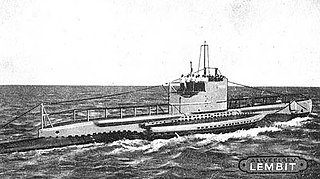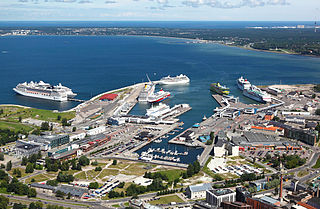
Miinisadam Naval Base ('Mine Harbor' Naval Base) is a naval base at Tallinn Bay, Tallinn. [1] The base is used since 1994 by Estonian Navy. Besides Estonian vessels the base accommodates also NATO countries' vessels. [2]

Miinisadam Naval Base ('Mine Harbor' Naval Base) is a naval base at Tallinn Bay, Tallinn. [1] The base is used since 1994 by Estonian Navy. Besides Estonian vessels the base accommodates also NATO countries' vessels. [2]

Tallinn is the capital and most populous city of Estonia. Situated on a bay in north Estonia, on the shore of the Gulf of Finland of the Baltic Sea, Tallinn has a population of about 457,000 and administratively lies in the Harju maakond (county). Tallinn is the main governmental, financial, industrial, and cultural centre of Estonia. It is located 187 km (116 mi) northwest of the country's second largest city, Tartu; however, only 80 km (50 mi) south of Helsinki, Finland, also 320 km (200 mi) west of Saint Petersburg, Russia, 300 km (190 mi) north of Riga, Latvia, and 380 km (240 mi) east of Stockholm, Sweden. From the 13th century until the first half of the 20th century, Tallinn was known in most of the world by variants of its other historical name Reval.

Aegna is an Estonian island in the Bay of Tallinn in the Baltic Sea. Administratively it is part of the city of Tallinn, the capital of Estonia and is a sub district of the Kesklinn district.

Harju County, is one of the fifteen counties of Estonia. It is situated in northern Estonia, on the southern coast of the Gulf of Finland, and borders Lääne-Viru County to the east, Järva County to the southeast, Rapla County to the south, and Lääne County to the southwest. The capital and largest city of Estonia, Tallinn, is situated in Harju County. Harju is the largest county in Estonia in terms of population, as almost half (45%) of Estonia's population lives in Harju County.

MS Estonia was a cruiseferry built in 1980 for the Finnish shipping company Rederi Ab Sally by Meyer Werft, in Papenburg, West Germany. It was employed on ferry routes between Finland and Sweden by various companies until the end of January 1993, when it was sold to Nordström & Thulin for use on Estline's Tallinn–Stockholm route. The ship's sinking on 28 September 1994, in the Baltic Sea between Sweden, Finland and Estonia, was one of the worst peacetime maritime disasters of the 20th century, claiming 852 lives. An official inquiry found that failure of the locks on the bow visor caused water to flood the car deck and quickly capsize the ship. The report also noted a lack of crew action. A 2023 investigation noted additional construction flaws in the bow visor.

Football Club Infonet Levadia Tallinn, commonly known as FCI Levadia, or simply as Levadia, is a professional football club based in Tallinn that competes in the Meistriliiga, the top flight of Estonian football. The club's home ground is Lilleküla Stadium.

The Baltic Fleet is the fleet of the Russian Navy in the Baltic Sea.

Paldiski is a town and Baltic Sea port located on the Pakri Peninsula in northwestern Estonia. Originally established as a small Swedish port known as Rågervik, it evolved into an important ice-free port upon being incorporated into the Russian Empire in the 18th century.

Naissaar is an island in Estonia. It is located in the Gulf of Finland, northwest of the capital city Tallinn, and is administratively part of Viimsi Parish. The island has an area of 18.6 square kilometres. It is 8 kilometres long and 3.5 kilometres wide, and lies about 8.5 kilometres from the mainland. The highest point on the island is Kunilamägi, which is 27 metres above sea level. The island consists predominantly of coniferous forest and piles of stones and boulders. In 2020, the island had a population of 17; in 2011 the island had about 35 permanent residents and some summer residents.

The Estonian Navy are the unified naval forces among the Estonian Defence Forces.

During World War II, the Estonian capital Tallinn suffered from many instances of aerial bombing by the Soviet air force and the German Luftwaffe. The first bombings by Luftwaffe occurred during the Summer War of 1941 as part of Operation Barbarossa. A number of Soviet bombing missions to then German-occupied Tallinn followed in 1942–1944.

EML Admiral Cowan (M313) is a Sandown-class minehunter. Formerly HMS Sandown, lead ship of her class of the Royal Navy, she is now an Estonian Navy ship. Renamed EML Admiral Cowan, she is the flagship of the Estonian Navy and part of the Estonian Navy's mine sweeping flotilla. Admiral Cowan is the lead vessel of the Estonian Navy Mineships Division and also the first of the three modernised Sandown class minehunters received.

The Soviet evacuation of Tallinn, also called Juminda mine battle, Tallinn disaster or Russian Dunkirk, was a Soviet operation to evacuate the 190 ships of the Baltic Fleet, units of the Red Army, and Soviet civilians from the fleet's encircled main base of Tallinn in Soviet-occupied Estonia during August 1941. Near Juminda peninsula Soviet fleet ran into minefield that had been laid by the Finnish and German navies, and were repeatedly attacked by aircraft and torpedo boats, incurring major losses.

EML Lembit is one of two Kalev-class mine-laying submarines built for the Republic of Estonia before World War II, and is now a museum ship in Tallinn. She was launched in 1936 at Vickers-Armstrongs, Barrow-in-Furness, and served in the Estonian Navy and the Soviet Navy. Until she was hauled out on 21 May 2011, Lembit was the oldest submarine still afloat in the world. Her sister ship, Kalev, was sunk in October 1941. Lembit is named for Lembitu, an Estonian ruler who resisted the Livonian Crusades.

EML Kalev was one of two submarines of the Republic of Estonia launched in 1936 at Vickers and Armstrongs Ltd. in England. Her sister, Lembit, survived the Second World War.

EML Olev (M415) is a Frauenlob-class minelayer of the Estonian Navy Mineships Division.

The 1st Infantry Brigade is an infantry brigade of the Estonian Land Forces. It is the primary military unit in Northern Estonia. The brigade headquarters is based at Tapa.

The Estonian Defence Forces is the unified military force of the Republic of Estonia. The Estonian Defence Forces consists of the Estonian Land Forces, the Estonian Navy, the Estonian Air Force, and the paramilitary Estonian Defence League. The national defence policy aims to guarantee the preservation of the independence and sovereignty of the state and maintain the integrity of its land area, territorial waters, airspace, and constitutional order. Its main goals remain the development and maintenance of a credible capability to defend the nation's vital interests and of the defence forces in a way that ensures their interoperability with the armed forces of NATO and European Union member states in order to participate in the full range of missions for these military alliances.

The Old City Harbour is the main passenger harbour in Tallinn, Estonia. Regular lines serve routes to Helsinki (Finland) and Stockholm (Sweden)

Paljassaare is the name of the Paljassaare Peninsula in the Tallinn Bay, and the name of a subdistrict in the district of Põhja-Tallinn in the city of Tallinn, the capital of Estonia. The subdistrict is located on the peninsula.

Suur Tõll is an Estonian steam-powered icebreaker preserved in the Estonian Maritime Museum in Tallinn. She was originally built for the Russian Empire in 1914 by AG Vulcan in Stettin, Germany, as Tsar Mikhail Feodorovich. In 1917, she was taken over by the Bolsheviks and renamed Volynets. However, in 1918 she was captured by Finland and served as Wäinämöinen until 1922, when she was handed over to Estonia according to the Treaty of Tartu and renamed Suur Tõll. When Estonia was occupied by the Soviet Union in 1940, the icebreaker rejoined the Soviet fleet and was again named Volynets. She remained in service until 1985.